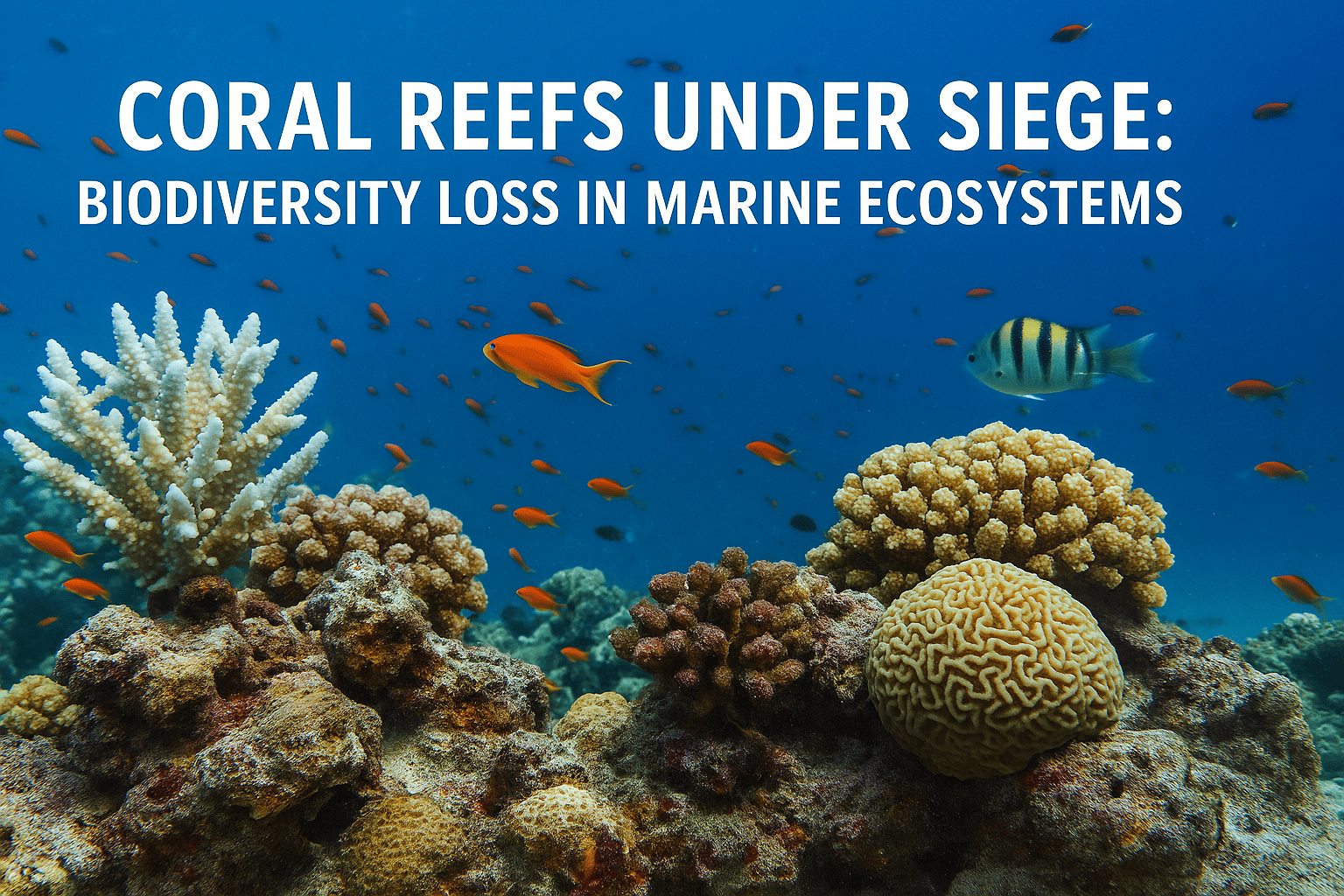Coral reefs are often described as the “rainforests of the sea” due to their immense biological diversity and ecological importance. Covering less than 1% of the ocean floor, these vibrant ecosystems support an estimated 25% of all marine life. Yet despite their ecological significance, coral reefs are under relentless threat from climate change, ocean acidification, pollution, and destructive fishing practices. This blog explores the multifaceted crisis affecting coral reef biodiversity and highlights global efforts to protect these essential ecosystems.
Importance of Coral Reefs in Biodiversity
Coral reefs serve as vital breeding grounds, feeding zones, and shelter for thousands of species of fish, crustaceans, mollusks, and other marine organisms. They also provide critical ecosystem services including coastal protection, nutrient cycling, and economic support through fisheries and tourism.
The structural complexity of coral reefs offers microhabitats for diverse species. Research published in the journal *Science* (Hughes et al., 2017) emphasizes that reef biodiversity contributes to ecosystem resilience, enabling reefs to recover more quickly from disturbances.
Causes of Coral Reef Decline
- Climate Change and Coral Bleaching
Coral bleaching occurs when elevated sea temperatures disrupt the symbiotic relationship between coral polyps and zooxanthellae (photosynthetic algae), causing the corals to expel them and lose their color. If prolonged, bleaching leads to coral death.
-2016–2017 Great Barrier Reef Bleaching Event: One of the most devastating in recorded history, affecting more than 90% of surveyed coral areas.
– Studies show that even 1.5°C of global warming could cause significant and irreversible damage to coral systems worldwide.
- Ocean Acidification
As atmospheric CO₂ levels rise, more carbon dioxide is absorbed by the oceans, leading to increased acidity. Acidic waters hinder the ability of corals and other calcifying organisms to build their calcium carbonate skeletons.
- Pollution
Nutrient Runoff from agriculture promotes algal blooms that smother coral reefs.
Plastic debris physically damages coral and can introduce pathogens.
Oil spills and industrial discharges add toxic substances to the marine environment.
4.Overfishing and Destructive Fishing Techniques
The use of cyanide and dynamite in fishing not only kills targeted fish but also causes irreversible damage to coral structures. Overfishing disrupts the food web, weakening the ecological balance.
Biodiversity at Risk
Coral reef decline imperils a multitude of marine species, including:
Herbivorous fish (e.g., parrotfish) that control algae growth
Predatory fish (e.g., groupers) that regulate smaller species populations
Invertebrates like sea urchins, crustaceans, and mollusks
Endemic species found nowhere else on Earth
According to the IUCN, over 30% of reef-building corals are at risk of extinction. The loss of these species could trigger cascading effects throughout the marine food web.
Conservation and Restoration Initiatives
Marine Protected Areas (MPAs)
MPAs such as the Great Barrier Reef Marine Park and Papahānaumokuākea Marine National Monument aim to limit human activity and allow ecosystems to regenerate. However, enforcement and climate resilience remain challenges.
Coral Farming and Restoration
Innovative techniques like coral gardening, micro fragmentation, and larval propagation are being employed to regrow damaged reefs. Organizations like the Coral Restoration Foundation have successfully transplanted thousands of coral fragments in Florida and the Caribbean.
Global Agreements and Policy Efforts
– **The Convention on Biological Diversity (CBD)** emphasizes the need to conserve at least 30% of marine habitats by 2030.
– **UN Sustainable Development Goal 14** targets the sustainable use of oceans and marine resources.
Local Community Engagement
Effective conservation often involves indigenous and coastal communities. Programs in Indonesia, the Philippines, and Palau integrate traditional knowledge with modern science to manage reef health.
Future Prospects and Innovations
Emerging technologies may offer new hope:
Genetic engineering to produce heat-resistant coral strains
Artificial reefs constructed from eco-friendly materials to provide alternative habitats
Remote sensing and AI to monitor reef conditions in real-time
However, these innovations must be paired with systemic changes in climate policy, pollution control, and public awareness to be effective.
Conclusion
The global biodiversity crisis unfolding in coral reefs is a stark reminder of the ocean’s fragility. These ecosystems, teeming with life and wonder, are not just natural marvels—they are essential to planetary health and human survival. The future of coral reefs will depend on a global commitment to reducing emissions, preserving marine habitats, and restoring what has already been lost.

